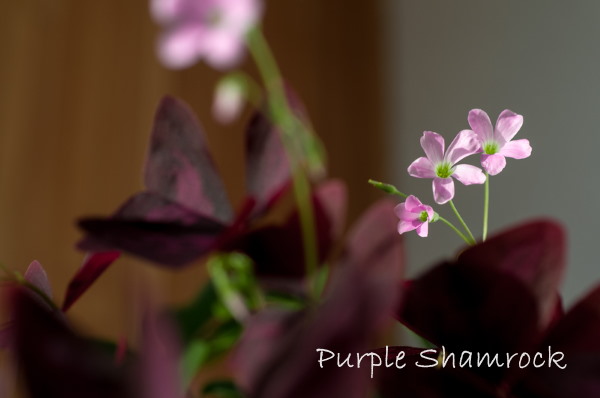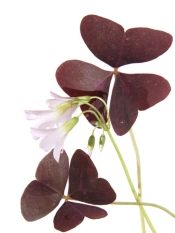Purple Shamrock Care Indoors
Botanical Name: Oxalis regnellii sp.
Purple Shamrock grows in a clump habit of striking purple foliage. Its triangular-shaped leaves fold along the vein and look like butterflies fluttering above slender stems.
 Pink flowers bloom in spring and summer. Photo © Oxana Pospelova
Pink flowers bloom in spring and summer. Photo © Oxana PospelovaGet to Know Purple Shamrock
Many varieties are available, including 'Triangularis' pictured here. Another common name for this plant is False Shamrock.
You can expect an abundance of soft-pink flowers to appear in spring and summer. Dainty, five-petaled blooms rise like trumpets above the mounds of purple, clover-like leaves.
Don't let its fragile appearance deceive you. This is one of the easiest flowering house plants to grow as long as you can keep it moist and shaded.
This happy-go-lucky plant seems content to be anywhere. You can grow Purple Shamrock indoors year-round, or move it outside on a shady patio for the summer.
It can be planted outdoors in frost-free regions, but it's fast-spreading and can be invasive in the garden. Confined to a container, it won't go anywhere.

Solutions, Answers and Special Helps
Flush your plant. Oxalis is sensitive to the salt buildup from fertilizers. You'll notice it as whitish deposits on the surface of the soil or around the rim of the planter. It's a good idea to flush the soil occasionally to rid the soil of excess salts, which can harm this plant's fleshy roots. Flush the pot every month or two by watering plants thoroughly with room-temperate water. Allow the water to drain through the drainage holes for a half-hour. Then flush it again. Empty the drainage tray afterward so that the plant is not sitting in water.
Is Oxalis dead or dormant? Flattened stems and dry, shriveled leaves may cause you to believe your houseplant has bit the dust. But don't give up on it! Although shamrock doesn't require a period of dormancy, it may happen. Oxalis plant may go dormant if the soil is allowed to dry out or if it's exposed to hot, direct sun. Don't worry, it will come back. Cut off the foliage at soil level, and with good care and you'll have a healthy, thriving purple shamrock plant in just a few weeks.
Something bugging your houseplant? Purple shamrock isn't a pest-magnet, but it's just as susceptible as any other indoor plant. Watch for thrips, whiteflies and spider mites. Isolate an infested plant and treat it right away with insecticidal soap. Insects tend to multiply quickly and will invade other houseplants. If your houseplant is badly infested, don't be afraid to cut it down to the soil level; this vigorous grower will soon replace them.
Wondering when to repot? Divide purple shamrock or repot it anytime. Use a pot with drainage holes to prevent soggy soil. If you want to use a decorative pot without drainage holes, use it as a cachepot. Just slip a plain nursery pot into the cachepot. I put pebbles in the bottom of cachepots to keep the plant above the drainage water.
Purple Shamrock Care Tips
Origin: Brazil
Height: 6-12 in (15-30 cm)
Light: Bright indirect light will give O. regnellii the best leaf color. Leggy, spindly growth is often caused by lack of light. Move the plant to a spot where it will get curtain-filtered light from a south-facing window.
Water: Water thoroughly to ensure all roots are wet. Dry pockets of soil may cause the plant to die back. Use a pot with drainage holes and empty the drainage tray so that the potting mix won't stay soggy, which can lead to root rot. Allow the surface of soil to dry between waterings, but never allow the potting medium to dry out.

Humidity: This Brazilian native prefers relative humidity around 50%. If indoor air is dry, try one of these easy ways to increase humidity for your plant.
Temperature: Prefers cool temperatures, especially while in bloom; 55-65°F/13-18°C at night, not warmer than 75°F/24°C during the day.
Soil: Any good potting mix
Fertilizer: Feed every 2 weeks while plant is growing with a balanced liquid fertilizer diluted by half. When blooming stops, feed every other month.
Propagation: Divide the plant by gently pulling apart its small, tuberous roots into smaller clumps and potting them in separate containers.


